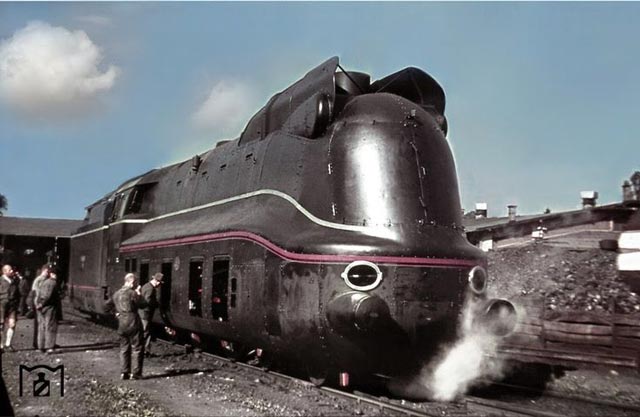The Wehrmacht Advanced with Panzers and Armored Cars? No, Horses and Trains
 |
| A German train of the World War II era. |
This reputation, however, was based on a secret that all the flashy tanks and artillery pieces camouflaged. The secret was that the Heer was, at its core, a 19th-Century army whose mobility was based upon trains and horses. It was lacking in virtually every material necessary to equip a modern army. It made do with what it had to the best of its ability while the Allies had enough oil and steel to make trucks in abundance. So, German troops relied on railroads and horses.
Germany's Strengths and Weaknesses
Germany had very few sources of oil, steel, rubber, and numerous other commodities that a military that is based around the internal combustion engine requires. Rubber was scarce because trade to its sources was cut off by the Royal Navy. There were simply inadequate sources of the other commodities (and the Reich had to import a lot of steel from “neutral” countries like Switzerland and Sweden). The Wehrmacht had to work within these limitations, and it did so by prioritizing systems that used materials that it had in abundance while limiting its scarce commodities to systems that absolutely required them. |
| A common scene in the Wehrmacht: men tending to their horses and wagons. |
Understanding the Reich’s infrastructure is absolutely critical to understanding the strengths and limitations of the Wehrmacht. Everyone knows about Hitler’s autobahns, and they were certainly extremely useful to his armies as they marched outward (and later to the Allies as they marched inward). However, what many people miss is the importance of the highly developed rail network of the Reichsbahn.
It is difficult to overestimate the importance of the railways for the Wehrmacht. Coal was plentiful, one of the few things in relative abundance, and that was ideal for the use of trains. They carried virtually everything of importance: freight, soldiers, products and supplies. If you look carefully at maps of the Wehrmacht’s front lines in the Soviet Union, you may notice a curious aspect: the front often bulged outward along rail lines. This especially was the case during the retreat in 1943–45 as oil supplies ran tight. This is not a coincidence.
 |
| A German armored train. All those vital railway lines had to be protected. |
German Strategy Revolved Around Rail Lines and Horses
German armies were absolutely dependent upon supplies and reinforcements brought to them by rail. Troops transferring from Germany to the front usually were brought to a railhead as close to the front as the lines ran and then got out and walked. Sure, the Germans had motor transport, but it was usually reserved for headquarters troops and the like. |
| If there were no trains available, horses and wagons were the only options even in the dead of winter. |
 |
| Realizing the critical importance of railroads to their own war effort, the Germans developed ways of denying those benefits to their enemies. Here, troops use the specially designed railroad track destroyer ("Schienenwolf") to rip up tracks in Italy during their retreat (Fraß, Federal Archive Bild 101I-308-0799R-11). |
Without available rail lines and horses, the Wehrmacht was immobile. That had a very big impact on the course of World War II.
 |
| The site of the bridge at Kalach then (below) and now. |
The Bridge at Kalach
Let me give you an example of how important the railroad-and-horse system was. When Stalingrad was surrounded, the Soviet objective in Operation Uranus was not Stalingrad itself. That could wait for later. The objective was the bridge at Kalach. Why was this bridge so important? Because it was over that one bridge that all the supplies for the Sixth Army and 3rd Romanian Army passed over.However, if you know a great deal about the Stalingrad battle, you know that wasn’t a railroad bridge. So, what gives? Well, the rail line from the West stopped at the Don River. Then, all supplies for the German Sixth Army and Romanian 3rd Army had to be loaded to vehicles, which then crossed the bridge at Kalach. The supplies were then re-loaded onto captured Russian trains on the other side of the river. Those trains then carried everything - men, food, ammunition, cigars, Schnapps - the remaining 64 km (40 miles) to Stalingrad.
 |
| The Germans even resorted to using local camels as pack animals at Stalingrad as shown here. Yes, there were camels on the steppe. |
 |
| Camouflaged Soviet tanks, accompanied by pack horses, advancing during Operation Uranus. |
German operations usually depended on two critical factors: the availability of rail lines and of horses. The OKH worried a great deal about the lack of horses by 1942 and they had to be prioritized to Army Group South to support Case Blue, the advance toward Stalingrad. This helps to explain why the line in the Army Group North and Army Group Center sectors of the front barely moved that year.
I talk more about the use of horses during World War II here and the Battle of Stalingrad here.
2020





No comments:
Post a Comment